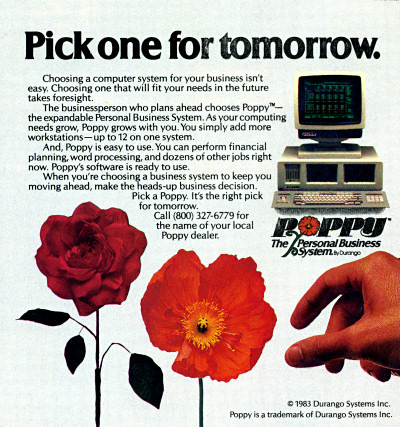[ Retro Scan of the Week ] The Poppy Computer
August 26th, 2013 by Benj Edwards Rose vs. Poppy: Which would you choose?
Rose vs. Poppy: Which would you choose?
I’ll admit that I’ve never encountered a Durango Poppy in person, nor do I know much about them aside from ads like this in old magazines.
So I did some digging, and I found that the Poppy model seen here was an 80186-based system that ran either MS-DOS for a single-user setup or Xenix for a multi-user configuration. It retailed for between $4,395 and $11,475 in early 1984 ($9,881 to $25,798 when adjusted for inflation), which was quite a bit of money — but actually far cheaper than IBM’s comparable offerings at the time.
A March 5, 1984 issue of InfoWorld available through Google Books has a neat article that mentions the Poppy.
I didn’t realize it at first, but the rose in the ad above is meant to symbolize IBM. IBM’s PC ads at the time featured Charlie Chaplin’s Tramp character, which always carried a rose.
Discussion Topic of the Week: Did you ever purposely pass up IBM hardware for a cheaper alternative? Tell us about it.






August 26th, 2013 at 11:33 am
Back in the day, I managed to convince the company I was working for to buy a Commodore PC-40 versus the IBM version. Saved a whole lot of money and got a better machine at the same time.
August 27th, 2013 at 1:36 pm
I saw plenty of PC clones among my friends in the 80s. There were a couple of Tandy 1000s, a Commodore PC (with monochrome Hercules graphics), a Laser XT clone with a hard drive that needed to be manually parked before you could power down the machine. Our first PC was a no-name beige box 386.
The closest I came to a genuine IBM was the room full of PS/2s at the high school, which were great for no other reason than their Model M keyboards.
I never saw an IBM in a home setting until the Aptiva in 1994.
August 29th, 2013 at 7:20 pm
I remember the old adage, “nobody ever got fired for buying IBM equipment.” Just think of the IT shops that couldn’t purchase a possibly better product because upper management was sold on the IBM brand.
December 28th, 2013 at 8:38 pm
At college here in the uk in the mid 80`s, we had quite a few Sanyo pc clones, they were not 100% compatable with ibm software (probably due to the weird hardware) and had a lot worse performance than the genuine ibm ones. They did look kinda cool though, quite slim and silver coloured.
Generally, pc`s were too expensive and graphically/sonically poor for home use and even the college didnt have many.
First one I saw in someones home that wasnt for business use was around the time Doom came out (1994?).
I also remember someone having a pc in an Amiga 500 style case around the same time, i think it was made by Amstrad or Sinclair Research. It really wasnt very good compared to, well anything else available at the time tbh.
October 1st, 2018 at 1:38 pm
The Poppy II included a socket for a then-very-new 80286 CPU. The Xenix system used this to run, with the 80186 providing the I/O. MS-DOS, of course, used only the 80186.
I was part of the development team on this system. Personally, I argued for the Motorola 68K as being more up to the task, but the Durango BOD had an Intel VP on it who stated unequivocally that it would be a cold day in hell before a Durango system would use a Motorola CPU.
I remember the many bugs in pre-release steppings of both the 186 and 286. Cost us a lot of time. Intel was tasked with getting the Xenix kernel running on the 286 and that wasn’t very timely either.
The terminal is a Beehive unit–a modified VT220 clone, IIRC.
I’d still like to get my hands on one of these, just for old times’ sake.
August 3rd, 2023 at 11:16 am
I remember things a bit differently than Chuck. Not sure though about a Poppy “II” but I got to take a look for a week or so at a Durango Poppy, which came with an 80186 only, running Microsoft’s Xenix (no 80286 anywhere). Xenix docs were dot matrix printed xerox copies, early preliminary version. Don’t recall much of problems with the CPU, just with Xenix docs and provided software being a bit “out of sync”…